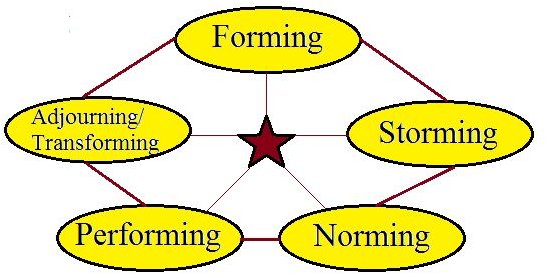The Five Stages of Team Development: How to Ensure Team Success
The Five Stages of Team Development
Most experts agree that teams progress through five different stages of development, which include forming, storming, norming, performing, and adjourning or transforming. This article discusses the five stages of team development, identifies the expected outcomes and challenges, and provides suggestions to ensure teams effectively move through each phase.
This diagram, created by N. Smith, identifies the typical order in which teams progress through each stage. However, the order can change depending on different circumstances.
Forming
Forming is the first of the five stages of team development and is when members meet for the first time. Team members begin gathering information about each other and the scope of work. Team members set ground rules and identify expectations. A team also defines the preliminary goals and action plans during this stage. However, the tasks often entail independent work.
Because of an individual’s need to be accepted, team members often avoid conflict during this stage. Team performance is hindered because many issues are avoided. Furthermore, team members can become confused about their role within the team, which can lead to frustration and uncertainty.
Storming
During the second stage, team members begin suggesting solutions to problems and identify more effective ways to achieve goals. The team is expected to identify what their role is, what they are expected to solve or produce, and how they are expected to function interdependently.
Although team members engage in rich conversations, they are not very trusting and often question other members’ suggestions, motives, and experiences. Furthermore, team members often focus too much on details, rather than the overarching issues, which can inhibit the ability to move past this stage of development.
Norming
Once a team is able to discuss and resolve differences, the team enters the norming stage where members agree on a common goal and a course of action to achieve that goal. The team demonstrates effective communication, trust in members’ abilities, and positive cooperation. However, even though some team members have to concede, all team members are expected to take responsibility for the decisions to be highly effective.
Performing
In the fourth stage, teams are performing well as a cohesive unit. There is little conflict, and teams are expected to work interdependently to make decisions, complete tasks, and foster team creativity and effectiveness. Members often share information, learn from one another, and are self-directive and motivating. The only challenge is keeping momentum going to ensure teams don’t resort back to previous stages, or, if they do, they are equipped to move through previous stages quickly and effectively.
Adjourning or Transforming
The final stage depends on the duration a team is expected to work together. For project-based teams, team members go through a phase of finalization where they celebrate successes. The challenge is to remain positive so members don’t loose focus when mourning over the dissolution of the team and the relationships that have formed. For continuous work teams, teams progress into the highest level of team development, which encompasses developing as individuals and adjusting to changing demands and expectations.
Ensuring Team Success
Although teams are expected to move through each of the five stages of team development, each team moves through them at a different pace and in a slightly different order. The following suggestions will help ensure teams are equipped to adequately address issues throughout the team development process and become highly productive.
- A leader must be identified to provide direction and guidance throughout the development process. To ensure the leader is well-accepted, a supervisor should not appoint a team leader; instead, the team should nominate and agree upon which member should assume that role.
- The team must discuss and agree upon their desired leadership style and communicate their expectations. Although the leader will assume all three roles throughout the process (authoritarian in the first two stages, delegative in the norming stage, and participative in the final two stages), the leader must be aware of the team’s expectations and roles for a leader.
- The team must determine how they will effectively discuss ideas and agree upon an appropriate course of action.
- Team members must be mature enough to exercise tolerance and patience for individual differences.
- The leader must redirect the team toward the end goal, help reinforce defined roles, address unacceptable behaviors, provide feedback, and facilitate team communication.
Understanding these five stages of team development and implementing these suggestions can help ensure teams have the necessary skills and tools to move through each phase, especially the storming phase, and to ensure successful outcomes and growth.
